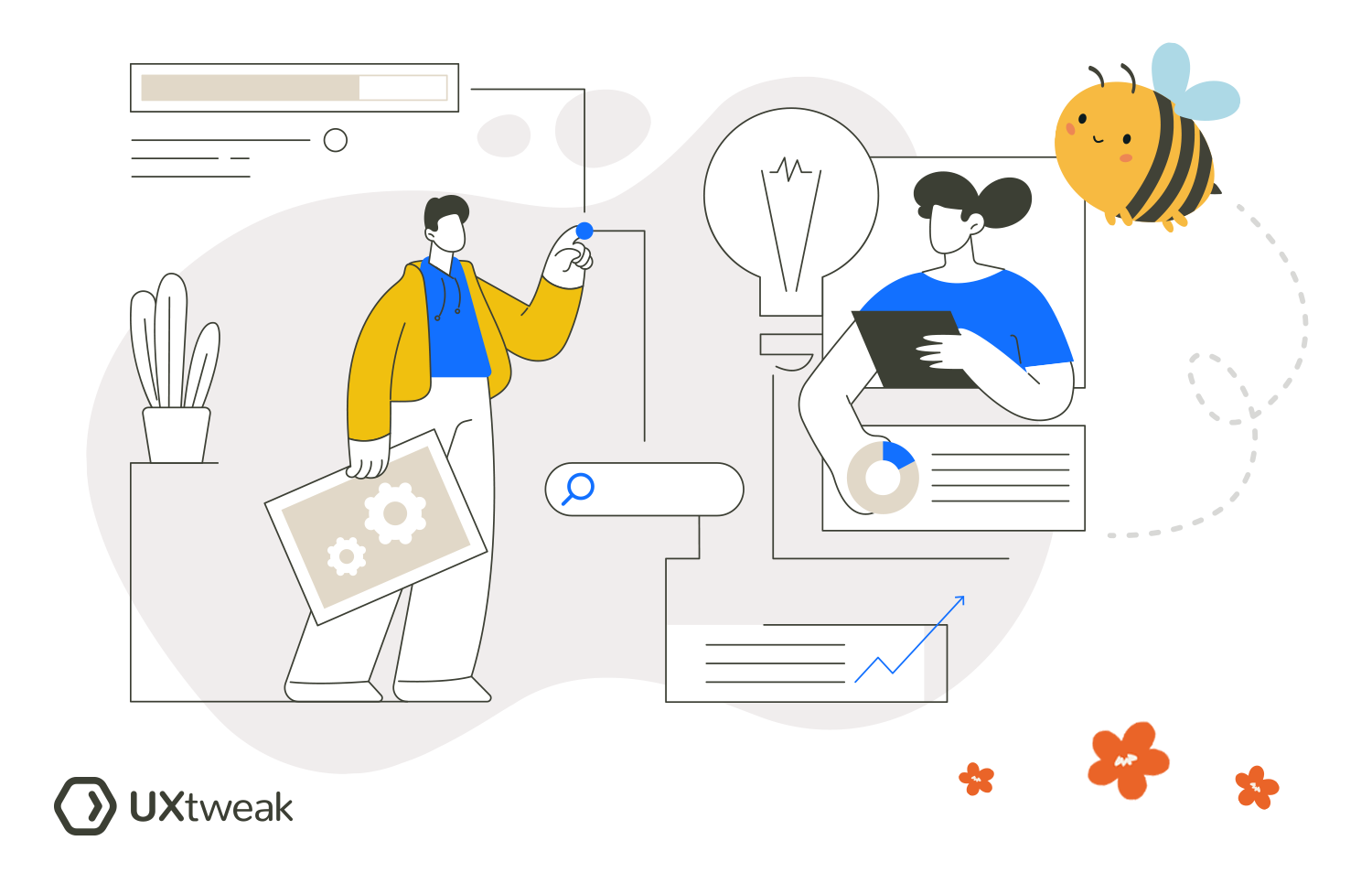One of the best ways to create a user-friendly experience, if not the best, is to invest heavily in a well-thought-out service design. Service design takes into account every interaction, aiming to make services smooth and valuable at every step.
In fact, according to Sahar Naderi:
What this also means is that by focusing on clear principles, companies can design services that not only meet user expectations but also support the people and processes behind the scenes.
In this article, we’ll cover ten essential service design principles that help create experiences users love, starting from the beginning of the design process down to the final stages.
What is service design?

Service design is about building services that make sense to users and support the teams behind them.
It considers each part of a service, from the moments customers interact with it, like through websites or support chats, to the internal systems that keep everything running smoothly.
The focus is on creating experiences that are seamless, user-friendly, and in tune with the needs of everyone involved.
Let’s take a look at the example.
A healthcare provider is looking to improve the way patients book appointments, communicate with doctors, and receive follow-up care. Service design would approach this by examining every aspect of that journey.
It would address how patients find appointment information, how doctors receive updates, and how follow-ups are managed. This approach doesn’t just enhance what users experience but makes sure the operational side supports it effectively.
Why service design matters?
Often, businesses start by designing user interfaces without mapping out the whole user journey or the systems that support it. Service design looks at the full picture, creating a well-structured service where each element works in harmony with the others.
This approach can be a game changer for customer satisfaction and how it organizes operations, making things easier for teams and helping achieve business goals.
A recent survey of 1,002 business leaders found that 38% weren’t familiar with service design, and 40% weren’t sure how it affected their projects.
This shows there’s still a big gap in understanding—and a real opportunity for companies to use service design to create better, more connected, and more efficient experiences.
But service design isn’t limited to digital products or customer service. It’s valuable wherever complex user interactions need to be organized in ways that feel intuitive and seamless.
10 key service design principles
Let’s go over ten key principles of service design, each one a building block for creating services that people genuinely enjoy and trust.
1. User-centricity
User-centricity in service design means focusing on the real needs and experiences of people using a service.
It also requires teams and product developers to step into users’ shoes to understand what makes a service enjoyable, accessible, and meaningful from start to finish.
A user-centered approach digs deep into each part of the journey, aiming to ensure that every interaction feels smooth and relevant.
Staying user-centered means regularly involving users in the design process to test your product with them and understand their unique needs.
Some ways to do this includes conducting user interviews and user testing of early versions of your prototypes, as well as collecting ongoing feedback.
For instance, a healthcare service may learn through user feedback that patients need faster access to follow-up appointments rather than just easier initial bookings.
With this insight, the service can prioritize improvements that genuinely matter, like automated reminders or quicker follow-up scheduling.
When services are designed with users’ needs in mind, satisfaction and loyalty often grow, which benefits both users and businesses.
2. Evidence-based approach
An evidence-based approach means making design decisions grounded in real data and research instead of assumptions. In service design, this principle keeps ideas practical and relevant to users’ actual needs and behaviors.
One way to implement this approach is by studying real-world evidence, that helps designers make choices that align closely with what users find helpful and engaging.
Collecting evidence can take many forms, like usability testing, customer feedback surveys, or even website analytics. Each source of information offers clues about what works well and where users encounter problems.
Try it yourself with UXtweak’s survey and usability testing and tools!🍯
Using evidence ensures that design decisions are relevant and effective, reducing the risk of building features that go unused.
When service changes are based on real feedback and data, they are far more likely to enhance the user experience in ways that feel meaningful and intuitive.
3. Focus on collaboration
Collaboration in service design is about bringing together everyone involved in creating the service, from designers and developers to customer support teams and managers.
When each team works together on shared goals, it becomes easier to make service design that’s consistent, efficient, and genuinely helpful for users.
Let’s say a transportation app team wants to improve the experience for users booking rides during peak hours. Instead of relying on isolated departments, they bring together designers, developers, customer service reps, and even drivers.
For instance, developers could design a feature showing real-time driver availability, while customer support teams might ask to add automated updates to reduce the number of inquiries during rush hour.
Together, these changes make a smoother experience for users while addressing practical needs from every angle.
A collaborative approach helps each team understand the bigger picture, leading to solutions that balances user needs with the company’s operational goals.
4. Holistic approach
The holistic approach in service design looks at the full picture of a user’s experience, taking into account every interaction they have with a service, both online and offline.
This means considering not just the product but also the processes, people, and support systems that impact how the service is delivered and experienced.
In other words, Instead of focusing on isolated parts, a holistic approach connects each piece, ensuring users have a seamless, consistent experience across all touchpoints.
For example, let’s say a health service provider aims to improve their patient onboarding process. A holistic approach here would mean looking beyond the initial appointment booking.
They’d also think about pre-appointment forms, wait times at the clinic, follow-up communication, and even the feedback process.
By seeing each step as part of a larger journey, they can identify small changes that make the whole experience smoother, like offering online form submissions to save time at check-in or sending reminders to reduce no-shows.
Each of these adjustments may seem minor on its own, but together, they create a more cohesive and positive experience for patients.
In practical terms, this holistic mindset often requires mapping out the entire user journey and identifying key touchpoints where users may feel frustrated.
5. Focus on prototyping and prototype testing
Prototyping and testing are essential in service design, allowing teams to bring ideas to life and see how they work in practice.
A prototype—whether it’s a simple sketch, clickable wireframe, or a fully functional version—lets designers and stakeholders visualize the service in action and identify potential issues before launching it to users.
Prototype testing gives a clear sense of what users find intuitive or confusing, allowing teams to refine details and improve usability.
For example, lets’ say a travel booking service wants to design a mobile-friendly booking interface for it’s users. Instead of guessing what layout or steps users will find easiest, the team can create a prototype and test it with real users.
With tools like UXtweak’s Prototype Testing Tool, they could observe how users navigate the booking process, identify where people encounter friction or take unexpected actions.
Feedback from usability tests can show them that users are struggling with too many steps in the booking process.
With this insight, they can simplify the flow, maybe by combining related steps or adding visual cues, creating a smoother experience from search to payment.
🔽 Ready to try prototyping yourself? Try UXtweak’s prototype usability testing and A/B testing demos!🍯
Prototyping doesn’t need to be complex to be effective. Starting with simple wireframes, teams can gather quick feedback, refining each stage until they reach a polished product.
Ultimately, paying a keen focus on prototyping and testing helps teams create services that feel natural and intuitive for users. This process reduces costly reworks after development and enables services to launch with greater confidence.
6. Iterative testing
Iterative testing is a core principle in service design that emphasizes ongoing, repeated testing to refine and perfect a service over time.
Rather than testing once and calling it done, iterative testing involves making small changes, gathering user feedback, and testing again.
This cycle of continuous improvement helps address issues as they arise and keeps the service in sync with evolving user needs.
Let’s take a restaurant reservation app as an example. After launching, the team notices from initial feedback that users struggle with locating their reservation history.
Instead of making assumptions, the team can undergo multiple rounds of usability testing, observing exactly where users are encountering confusion.
They might discover that users are expecting the reservation history to be accessible on the main screen rather than tucked away under an account menu.
After adjusting the design, they test again to see if this change resolves the issue. If it does, they move forward; if not, they continue refining.
Each round of testing offers insights that bring the service one step closer to being as seamless and user-friendly as possible.
With UXtweak’s prototype testing, iterative testing is easy and straightforward—allowing teams to test and re-test specific areas of their service, from navigation flow to feature accessibility. Try it today for free! 🐝
7. Transparency
Transparency in service design means openly communicating with users about what to expect, why certain processes are in place, and how their data or feedback is used.
Clear communication builds trust, especially when services involve complex steps or sensitive information. When users understand what’s happening behind the scenes, they’re more likely to feel confident and supported.
A financial planning app might choose to explain each step of their data collection process. Instead of simply asking for access to a user’s financial history, they could clarify why they need this information and how it’s used to tailor financial advice.
Transparency here assures users that their data is respected and safe, and helps users feel involved rather than kept in the dark.
A practical way to incorporate transparency is through real-time feedback or progress updates within a service.
Transparency also fosters a sense of accountability. Users are more likely to trust the service when their feedback influences changes or how their input directly affects service improvements.
8. Modularity
Modularity is all about designing services with separate, independent parts. This approach allows for flexibility, making it easier to update and adapt the service over time.
Instead of relying on a single, rigid structure, modular design breaks services down into smaller components that can be changed or improved without affecting the entire system.
If users find one area hard to navigate, the team can address just that part, making changes without disrupting other components. This targeted effort speeds up the design process and helps smooth the user experience.
Modularity also promotes collaboration among different teams. Each department can work on its own module independently. For example, while one team refines the user interface for a particular feature, another team can focus on marketing strategies.
This allows everyone to concentrate on their strengths while still contributing to a cohesive service.
Using design tools enables teams to gather user feedback on each module. This feedback helps identify which parts are effective and which ones need adjustments.
When users struggle with a specific module, the team can quickly make changes based on that input.
Adopting a modular approach in service design leads to better user experiences. The service can evolve easily as user preferences shift, ensuring it remains relevant and useful.
9. Scalability
Scalability in service design refers to the ability to grow and adapt as demand changes. A scalable service can handle increasing user numbers or expanded features without compromising quality.
This principle ensures that as your user base grows or their needs evolve, the service can adjust smoothly and efficiently.
When a service is designed with scalability in mind, it can accommodate more users without requiring a complete overhaul.
For instance, a platform that starts with a small group of users can expand its infrastructure to support thousands more without significant delays.
This means users can continue enjoying a seamless experience, regardless of how much the service grows.
Scalability also involves planning for future improvements. Designers should consider how easy it will be to add new features down the line.
For example, if a company wants to introduce a new payment method or service option, a scalable design allows for these additions without disrupting existing functionality.
This forward-thinking approach can save time and resources, making it easier to respond to market changes.
Another important aspect of scalability is performance. A well-designed service maintains its performance levels, even as the number of users increases.
This requires optimizing various elements, such as server capacity and response times, to ensure that the service remains efficient under heavy loads.
10. Simplicity
Simplicity in service design is all about making things easy for users. The goal is to remove anything that complicates the experience, allowing users to quickly understand how to use the service.
When a service is simple, it encourages people to engage and enjoy their experience.
A simple design eliminates unnecessary steps. For instance, when you visit a website, you shouldn’t have to search hard for what you need.
Everything should be laid out clearly, guiding you directly to your goal. By concentrating on essential features, designers can create a smoother journey for users.
Clear language plays a big role in achieving simplicity. Instructions should be straightforward and easy to follow. Visual elements, like icons or diagrams, can help clarify processes, making it easier for users to grasp how things work.
The aim is to present information in a way that feels natural.
Consistency is another key factor. Keeping design elements uniform helps users feel comfortable navigating the service. If buttons and menus look and function similarly throughout, users can find their way around without hesitation.
This familiarity builds trust and encourages continued use.
A simple design not only makes tasks easier but also keeps users coming back. When users can accomplish their goals without hassle, they are more likely to return.
In summary, focusing on simplicity in service design leads to a better experience for everyone. It makes services approachable and encourages ongoing engagement.
How to apply service design principles

📍 Start with user research. Begin by understanding your users. Conduct interviews, surveys, or focus groups to gather insights about their needs and challenges.
Run moderated tests so you can see how users engage with your service. This feedback is essential for making informed design choices.
📍 Utilize design thinking. Design thinking encourages you to empathize with users, define their problems, brainstorm solutions, create prototypes, and test them.
Organizing workshops and collaborative sessions brings different perspectives together, promoting creativity. Use tools like Miro or Figma to create visual representations of your ideas, making collaboration smoother.
📍 Implement prototyping and testing. Prototyping helps you create a version of your service that users can interact with. Tools like InVision or Adobe XD allow you to build interactive prototypes.
Conduct usability tests to collect feedback and identify areas for improvement. This iterative approach helps your design evolve based on real user input.
📍 Focus on clarity and simplicity. As you refine your service, aim for clarity in both language and design. Make sure instructions are straightforward and navigation is easy.
Simplicity helps users feel confident in using your service, which encourages ongoing engagement.
📍 Foster collaboration across teams. Service design involves many departments. Regular check-ins and workshops can keep everyone aligned on shared goals and user needs. This teamwork promotes a comprehensive approach to service design.
Understanding the differences between customer experience (CX), user experience (UX), and service design is also important. Knowing how these areas connect can improve your design process.
Wrapping up
Remember, putting these principles into practice is not a one-time task; it’s an ongoing journey. Regularly revisit your designs, use user feedback tools, and stay open to adjustments.
This iterative mindset allows you to adapt and evolve as user needs change, ultimately leading to more meaningful interactions.
Moreover, understanding the connections between service design, CX, and UX deepens your insights and improves your design strategies.
Each area contributes to creating a well-rounded experience that meets users’ expectations and enhances satisfaction.
If you value and consider your users’ feedback every step of the way, UXtweak is the only way to go.
With powerful tools for usability testing, A/B testing, session recording, and real-time feedback, you get fresh, actionable insights anytime (not just when a project demands it). Try it for free today! 🐝









